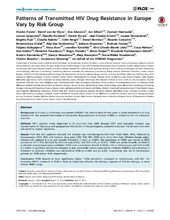| dc.contributor.author | Frentz, Dineke | en_US |
| dc.contributor.author | van de Vijver, David A. | en_US |
| dc.contributor.author | Abecasis, Ana B. | en_US |
| dc.contributor.author | Albert, Jan | en_US |
| dc.contributor.author | Hamouda, Osamah | en_US |
| dc.contributor.author | Jørgensen, Louise B. | en_US |
| dc.contributor.author | Kücherer, Claudia | en_US |
| dc.contributor.author | Struck, Daniel | en_US |
| dc.contributor.author | Schmit, Jean-Claude | en_US |
| dc.contributor.author | Vercauteren, Jürgen | en_US |
| dc.contributor.author | Åsjø, Birgitta | en_US |
| dc.contributor.author | Balotta, Claudia | en_US |
| dc.contributor.author | Bergin, Colm | en_US |
| dc.contributor.author | Beshkov, Danail | en_US |
| dc.contributor.author | Camacho, Ricardo | en_US |
| dc.contributor.author | Clotet, Bonaventura | en_US |
| dc.contributor.author | Griskevicius, Algirdas | en_US |
| dc.contributor.author | Grossman, Zehava | en_US |
| dc.contributor.author | Horban, Andrzej | en_US |
| dc.contributor.author | Kolupajeva, Tatjana | en_US |
| dc.contributor.author | Korn, Klaus | en_US |
| dc.contributor.author | Kostrikis, Leondios | en_US |
| dc.contributor.author | Linka, Kirsi Litsola Marek | en_US |
| dc.contributor.author | Nielsen, Claus | en_US |
| dc.contributor.author | Otelea, Dan | en_US |
| dc.contributor.author | Paraskevis, Dimitrios | en_US |
| dc.contributor.author | Paredes, Roger | en_US |
| dc.contributor.author | Poljak, Mario | en_US |
| dc.contributor.author | Puchhammer-Stöckl, Elisabeth | en_US |
| dc.contributor.author | Sönnerborg, Anders | en_US |
| dc.contributor.author | Stanekova, Danica | en_US |
| dc.contributor.author | Stanojevic, Maja | en_US |
| dc.contributor.author | Vandamme, Anne-Mieke | en_US |
| dc.contributor.author | Boucher, Charles A.B. | en_US |
| dc.contributor.author | Wensing, Annemarie | en_US |
| dc.date.accessioned | 2015-03-27T13:25:43Z | |
| dc.date.available | 2015-03-27T13:25:43Z | |
| dc.date.issued | 2014-04-10 | eng |
| dc.identifier.issn | 1932-6203 | |
| dc.identifier.uri | https://hdl.handle.net/1956/9690 | |
| dc.description.abstract | Background: In Europe, a continuous programme (SPREAD) has been in place for ten years to study transmission of drug resistant HIV. We analysed time trends of transmitted drug resistance mutations (TDRM) in relation to the risk behaviour reported. Methods: HIV-1 patients newly diagnosed in 27 countries from 2002 through 2007 were included. Inclusion was representative for risk group and geographical distribution in the participating countries in Europe. Trends over time were calculated by logistic regression. Results: From the 4317 patients included, the majority was men-having-sex-with-men -MSM (2084, 48%), followed by heterosexuals (1501, 35%) and injection drug users (IDU) (355, 8%). MSM were more often from Western Europe origin, infected with subtype B virus, and recently infected (<1 year) (p<0.001). The prevalence of TDRM was highest in MSM (prevalence of 11.1%), followed by heterosexuals (6.6%) and IDU (5.1%, p,0.001). TDRM was predominantly ascribed to nucleoside reverse transcriptase inhibitors (NRTI) with a prevalence of 6.6% in MSM, 3.3% in heterosexuals and 2.0% in IDU (p = 0.001). A significant increase in resistance to non- nucleoside reverse transcriptase inhibitors (NNRTIs) and a decrease in resistance to protease inhibitors was observed in MSM (p = 0.008 and p = 0.006, respectively), but not in heterosexual patients (p = 0.68 and p = 0.14, respectively). Conclusions: MSM showed to have significantly higher TDRM prevalence compared to heterosexuals and IDU. The increasing NNRTI resistance in MSM is likely to negatively influence the therapy response of first-line therapy, as most include NNRTI drugs. | en_US |
| dc.language.iso | eng | eng |
| dc.publisher | PLoS | eng |
| dc.rights | Attribution CC BY | eng |
| dc.rights.uri | http://creativecommons.org/licenses/by/4.0 | eng |
| dc.title | Patterns of transmitted HIV drug resistance in Europe vary by risk group | en_US |
| dc.type | Peer reviewed | |
| dc.type | Journal article | |
| dc.date.updated | 2015-03-03T16:23:11Z | en_US |
| dc.description.version | publishedVersion | en_US |
| dc.rights.holder | Copyright 2014 Frentz et al | |
| dc.source.articlenumber | e94495 | |
| dc.identifier.doi | https://doi.org/10.1371/journal.pone.0094495 | |
| dc.identifier.cristin | 1164513 | |
| dc.source.journal | PLoS ONE | |
| dc.source.40 | 9 | |
| dc.source.14 | 4 | |
| dc.subject.nsi | VDP::Medical sciences: 700::Basic medical, dental and veterinary sciences: 710::Medical immunology: 716 | eng |
| dc.subject.nsi | VDP::Medisinske fag: 700::Basale medisinske, odontologiske og veterinærmedisinske fag: 710::Medisinsk immunologi: 716 | nob |

